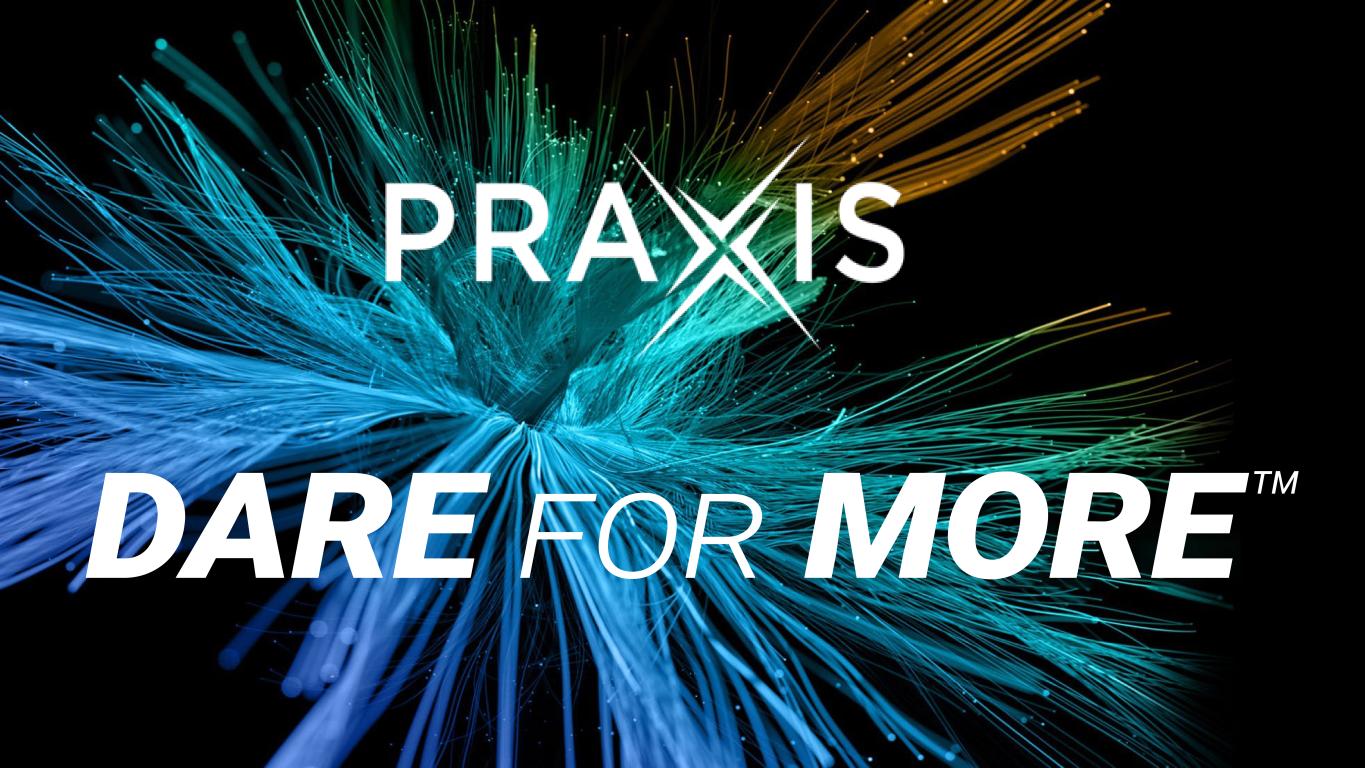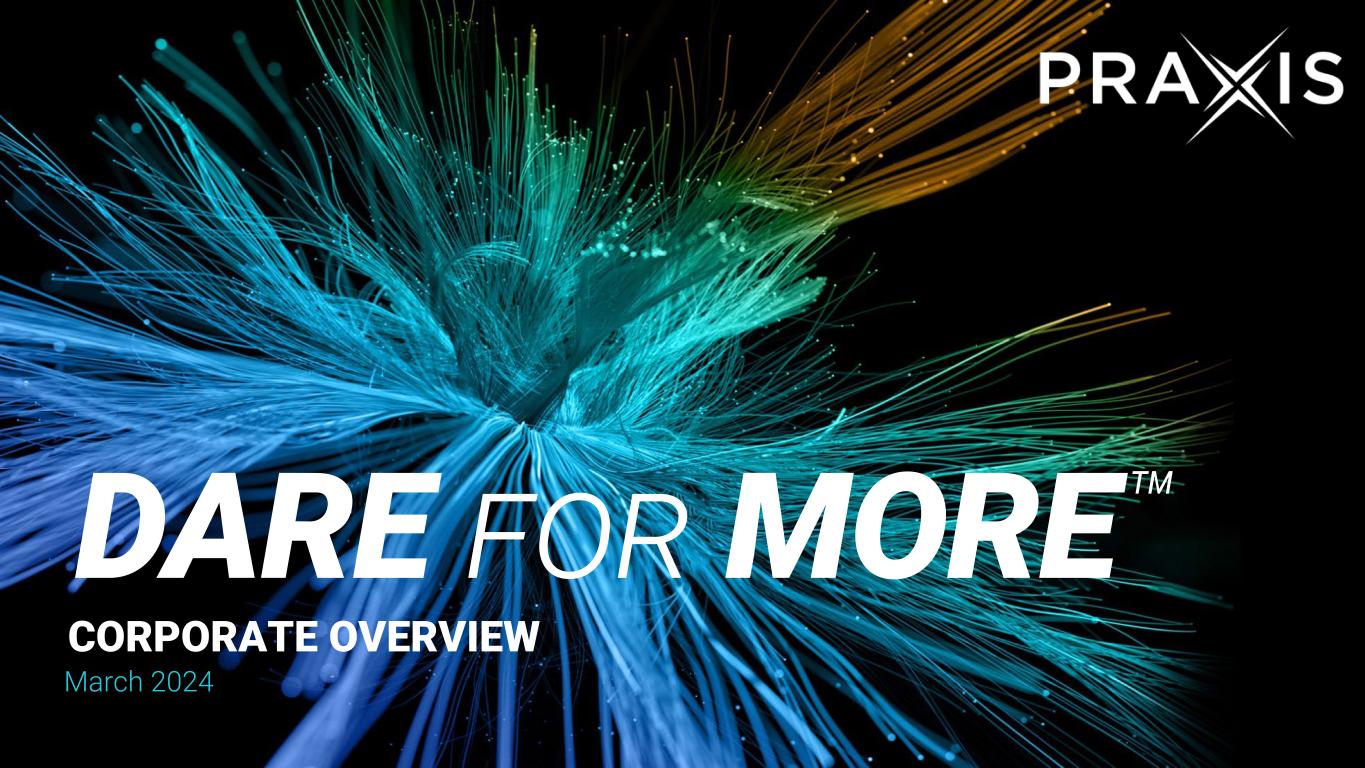
CORPORATE OVERVIEW March 2024

2 Forward-looking statements This presentation may contain “forward-looking statements” within the meaning of the Private Securities Litigation Reform Act of 1995 relating to our business, operations, and financial conditions, including but not limited to express or implied statements regarding the current beliefs, expectations and assumptions regarding the future of our business, future plans and strategies, our development plans, our preclinical and clinical results and other future conditions. Any forward-looking statements in this presentation are based on management’s current expectations and beliefs and are subject to a number of risks, uncertainties and important factors that may cause actual events or results to differ materially from those expressed or implied by any forward-looking statements contained in this presentation, including, without limitation, risks relating to: (i) the success and timing of our ongoing clinical trials, (ii) the success and timing of our product development activities and initiating clinical trials, (iii) the success and timing of our collaboration partners’ product development activities, (iv) the timing of and our ability to obtain and maintain regulatory approval of any of our product candidates, (v) our plans to research, discover and develop additional product candidates, (vi) our ability to enter into collaborations for the development of new product candidates, (vii) our ability to establish manufacturing capabilities, and our collaboration partners’ abilities to manufacture our product candidates and scale production, (viii) our ability to meet any specific milestones set forth herein, and (ix) the potential addressable market sizes for product candidates. New risks and uncertainties may emerge from time to time, and it is not possible to predict all risks and uncertainties. Except as required by applicable law, we do not plan to publicly update or revise any forward-looking statements contained herein, whether as a result of any new information, future events, changed circumstances or otherwise. Although we believe the expectations reflected in such forward-looking statements are reasonable, we can give no assurance that such expectations will prove to be correct. Accordingly, readers are cautioned not to place undue reliance on these forward-looking statements. For further information regarding the risks, uncertainties and other factors that may cause differences between our expectations and actual results, you should review the “Risk Factors” section of our Annual Report on Form 10-K for the year ended December 31, 2023 to be filed and other filings with the Securities and Exchange Commission. Certain information contained in this presentation relates to or is based on studies, publications, surveys and other data obtained from third-party sources and our own internal estimates and research. While we believe these third-party sources to be reliable as of the date of this presentation, we have not independently verified, and make no representation as to the adequacy, fairness, accuracy or completeness of, any information obtained from third-party sources. In addition, all of the market data included in this presentation involves a number of assumptions and limitations, and there can be no guarantee as to the accuracy or reliability of such assumptions. Finally, while we believe our own internal research is reliable, such research has not been verified by any independent source.
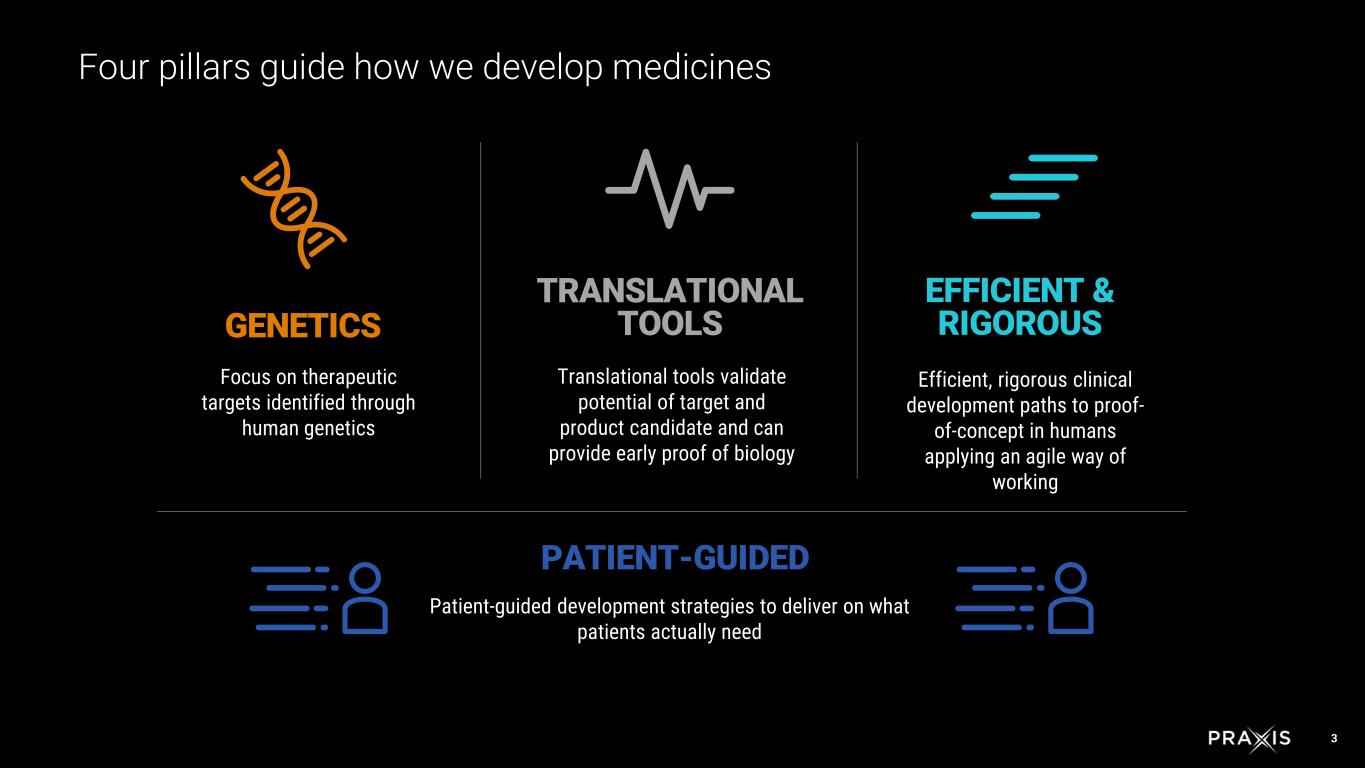
3 GENETICS Focus on therapeutic targets identified through human genetics TRANSLATIONAL TOOLS Translational tools validate potential of target and product candidate and can provide early proof of biology EFFICIENT & RIGOROUS Efficient, rigorous clinical development paths to proof- of-concept in humans applying an agile way of working PATIENT-GUIDED Patient-guided development strategies to deliver on what patients actually need Four pillars guide how we develop medicines
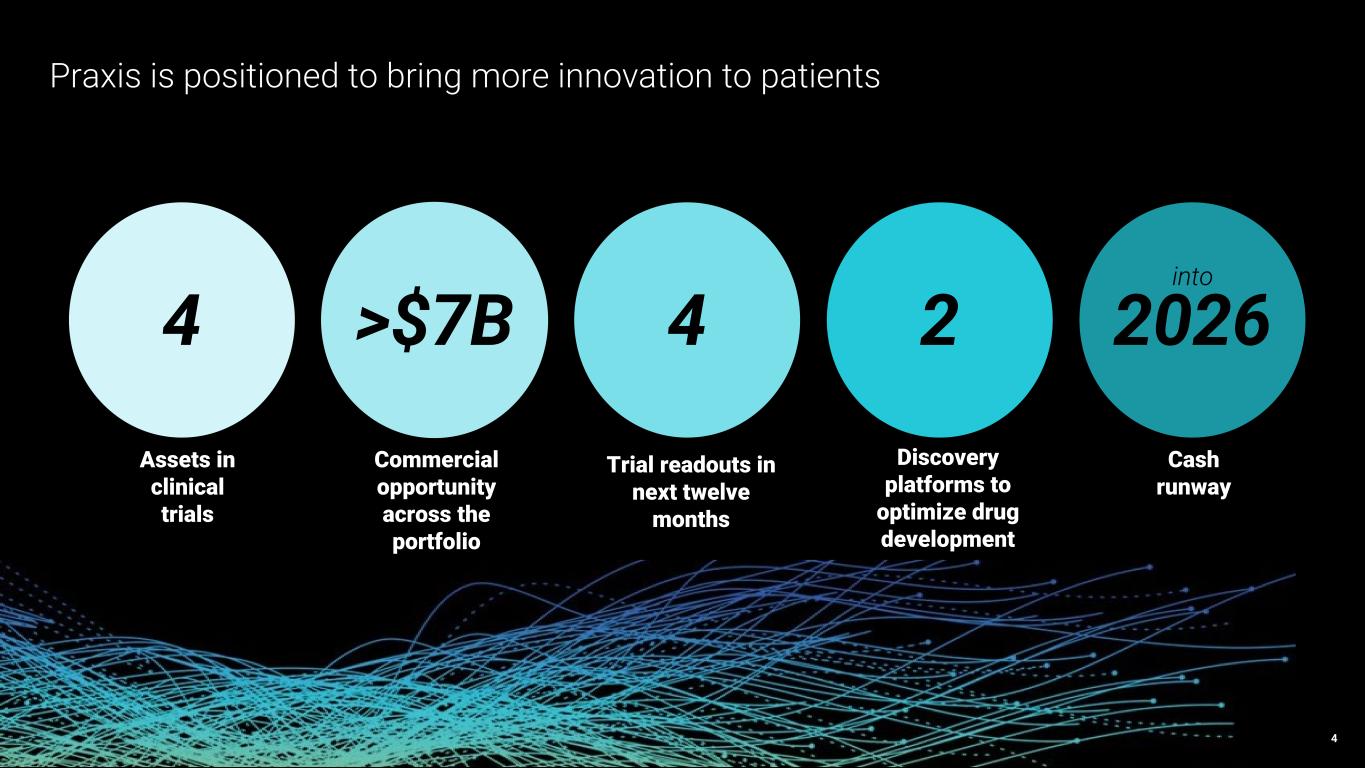
4 4 >$7B 4 2 2026 Praxis is positioned to bring more innovation to patients Assets in clinical trials Commercial opportunity across the portfolio Trial readouts in next twelve months Discovery platforms to optimize drug development Cash runway into
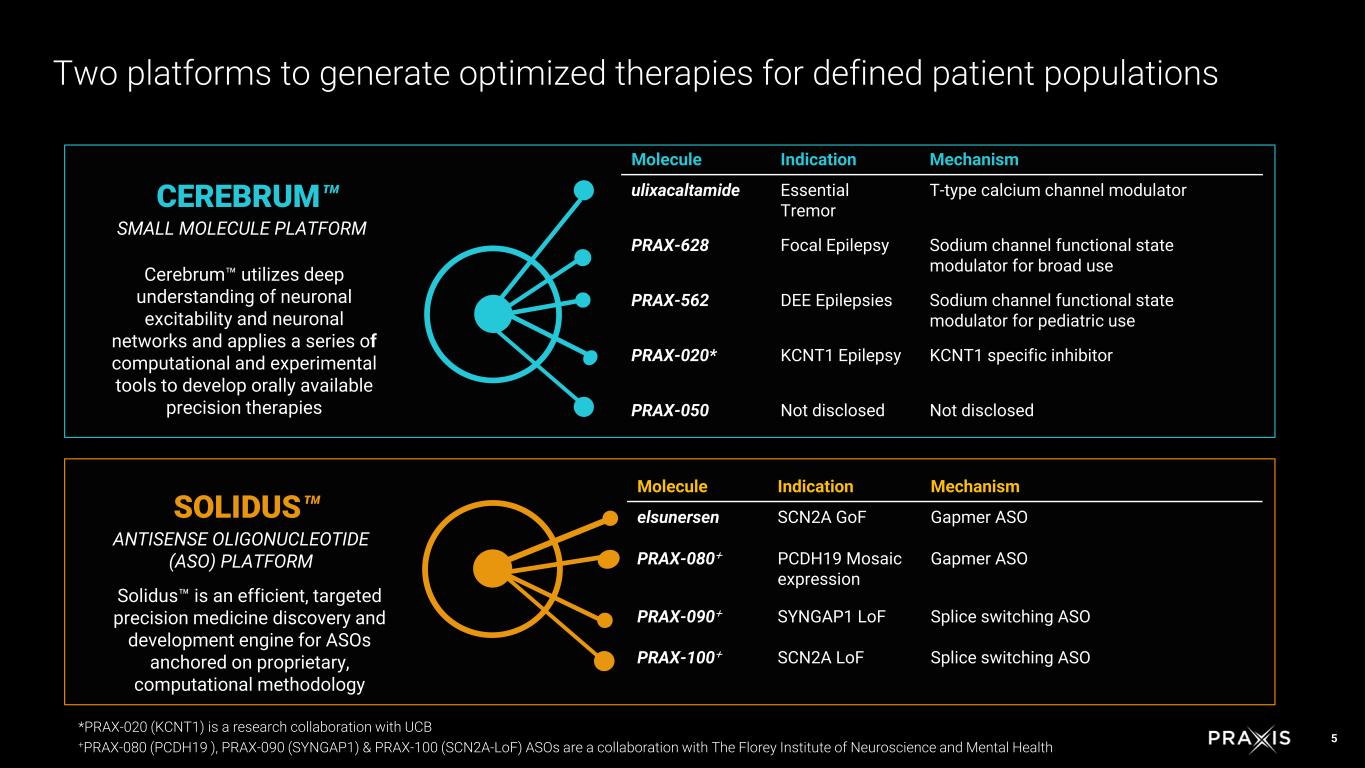
5 CEREBRUM SMALL MOLECULE PLATFORM Cerebrum utilizes deep understanding of neuronal excitability and neuronal networks and applies a series of computational and experimental tools to develop orally available precision therapies SOLIDUS ANTISENSE OLIGONUCLEOTIDE (ASO) PLATFORM Solidus is an efficient, targeted precision medicine discovery and development engine for ASOs anchored on proprietary, computational methodology Two platforms to generate optimized therapies for defined patient populations Molecule Indication Mechanism ulixacaltamide Essential Tremor T-type calcium channel modulator PRAX-628 Focal Epilepsy Sodium channel functional state modulator for broad use PRAX-562 DEE Epilepsies Sodium channel functional state modulator for pediatric use PRAX-020* KCNT1 Epilepsy KCNT1 specific inhibitor PRAX-050 Not disclosed Not disclosed Molecule Indication Mechanism elsunersen SCN2A GoF Gapmer ASO PRAX-080+ PCDH19 Mosaic expression Gapmer ASO PRAX-090+ SYNGAP1 LoF Splice switching ASO PRAX-100+ SCN2A LoF Splice switching ASO *PRAX-020 (KCNT1) is a research collaboration with UCB +PRAX-080 (PCDH19 ), PRAX-090 (SYNGAP1) & PRAX-100 (SCN2A-LoF) ASOs are a collaboration with The Florey Institute of Neuroscience and Mental Health

6 PHASE TWO *PRAX-020 (KCNT1) is a research collaboration with UCB +PRAX-080 (PCDH19 ), PRAX-090 (SYNGAP1) & PRAX-100 (SCN2A-LoF) ASOs are a collaboration with The Florey Institute of Neuroscience and Mental Health PRECLINICAL PHASE ONE PHASE THREEPLATFORM PRAX-020* KCNT1 PRAX-050 Undisclosed PRAX-090+ SYNGAP1 PRAX-100+ SCN2A LoF PRAX-080+ PCDH19 CEREBRUM SMALL MOLECULE PLATFORM SOLIDUS ASO PLATFORM Elsunersen SCN2A GoF DEE Ulixacaltamide Essential Tremor PRAX-562 DEEs PRAX-628 Focal Epilepsy Four clinical stage assets and multitude of early-stage programs UPCOMING MILESTONES Elsunersen • 1H: Regulatory alignment on registrational program PRAX-562 • Mid-year: Ph 2 EMBOLD Study topline Results PRAX-628 • Q1: Phase 2 PPR study topline results • 2H: Initiate Focal Epilepsy Phase 2 Study Ulixacaltamide • 1H: Complete enrollment • 2H: Topline results
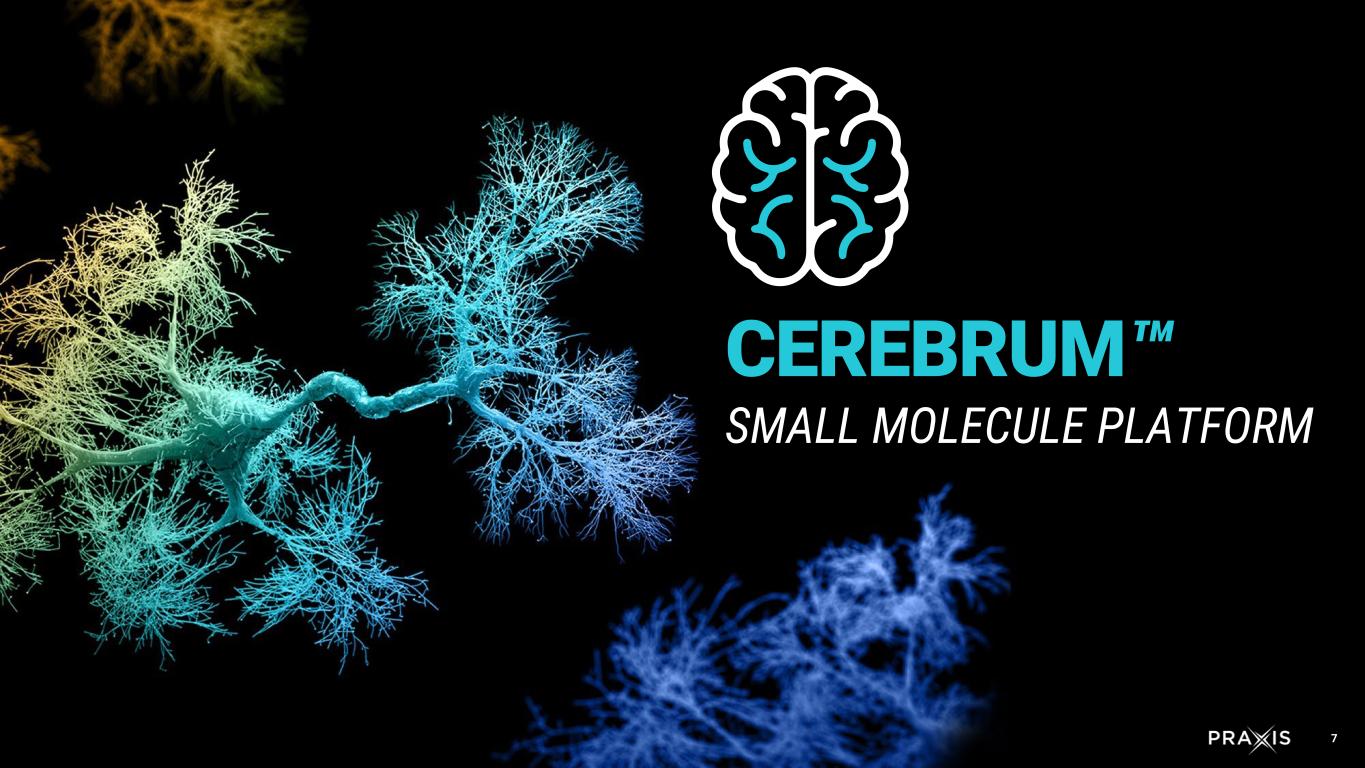
7 CEREBRUM SMALL MOLECULE PLATFORM

8 Ulixacaltamide Milestones 1H 2024: Enrollment complete 2H 2024: Topline results 2025: File NDA

9 Essential tremor market is significantly underserved and ready for disruption $4bn+ US ET Market SOURCE: Vetterick, C., Lyons, K.E., Matthews, L.G. et al. The Hidden Burden of Disease and Treatment Experiences of Patients with Essential Tremor: A Retrospective Claims Data Analysis. Adv Ther (2022). https://doi.org/10.1007/s12325-022-02318-8 1. GHOSH (2016) (P.231, C.1, PH.1, L.1-2), 2. Elble RJ. Curr Neurol Neurosci Rep. 2013 Jun;13(6):353. 3. Putzke JD, et al. J Neurol Neurosurg Psychiatry. 2006 Nov;77(11):1235-7. 4. Vetterick, C., Lyons, K.E., Matthews, L.G. et al. The Hidden Burden of Disease and Treatment Experiences of Patients with Essential Tremor: A Retrospective Claims Data Analysis. Adv Ther (2022). https://doi.org/10.1007/s12325-022-02318-8 • Essential Tremor (ET) is the most prevalent movement disorder • People with ET experience significant disruption of their daily activities • Hallmark feature of ET is action tremor that primarily affects the hands2,3 • Almost all ET patients suffer from at least one comorbid condition (e.g., depression, anxiety, sleep disorders, cognitive dysfunction)4 Vast majority of the patients are left without any treatment option • <30% of patients are eligible to receive propranolol due to other medications/health conditions • Of those who start propranolol >50% discontinue after only 1 month • Of those who start propranolol <20% still receive propranolol after 2 years ~2M ET patients seeking treatment 7M US Prevalence1
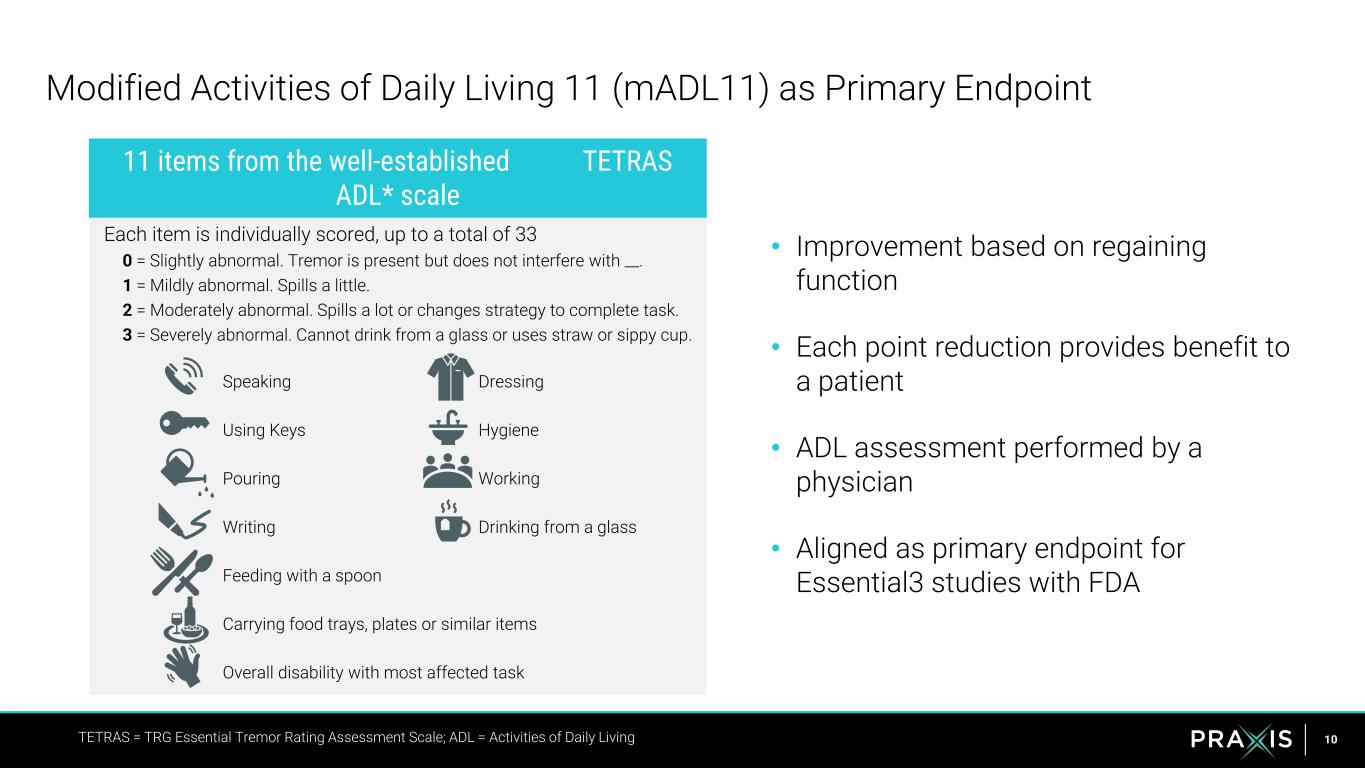
10 Speaking Dressing Using Keys Hygiene Pouring Working Writing Drinking from a glass Feeding with a spoon Carrying food trays, plates or similar items Overall disability with most affected task • Improvement based on regaining function • Each point reduction provides benefit to a patient • ADL assessment performed by a physician • Aligned as primary endpoint for Essential3 studies with FDA Modified Activities of Daily Living 11 (mADL11) as Primary Endpoint TETRAS = TRG Essential Tremor Rating Assessment Scale; ADL = Activities of Daily Living Each item is individually scored, up to a total of 33 0 = Slightly abnormal. Tremor is present but does not interfere with __. 1 = Mildly abnormal. Spills a little. 2 = Moderately abnormal. Spills a lot or changes strategy to complete task. 3 = Severely abnormal. Cannot drink from a glass or uses straw or sippy cup. 11 items from the well-established TETRAS ADL* scale
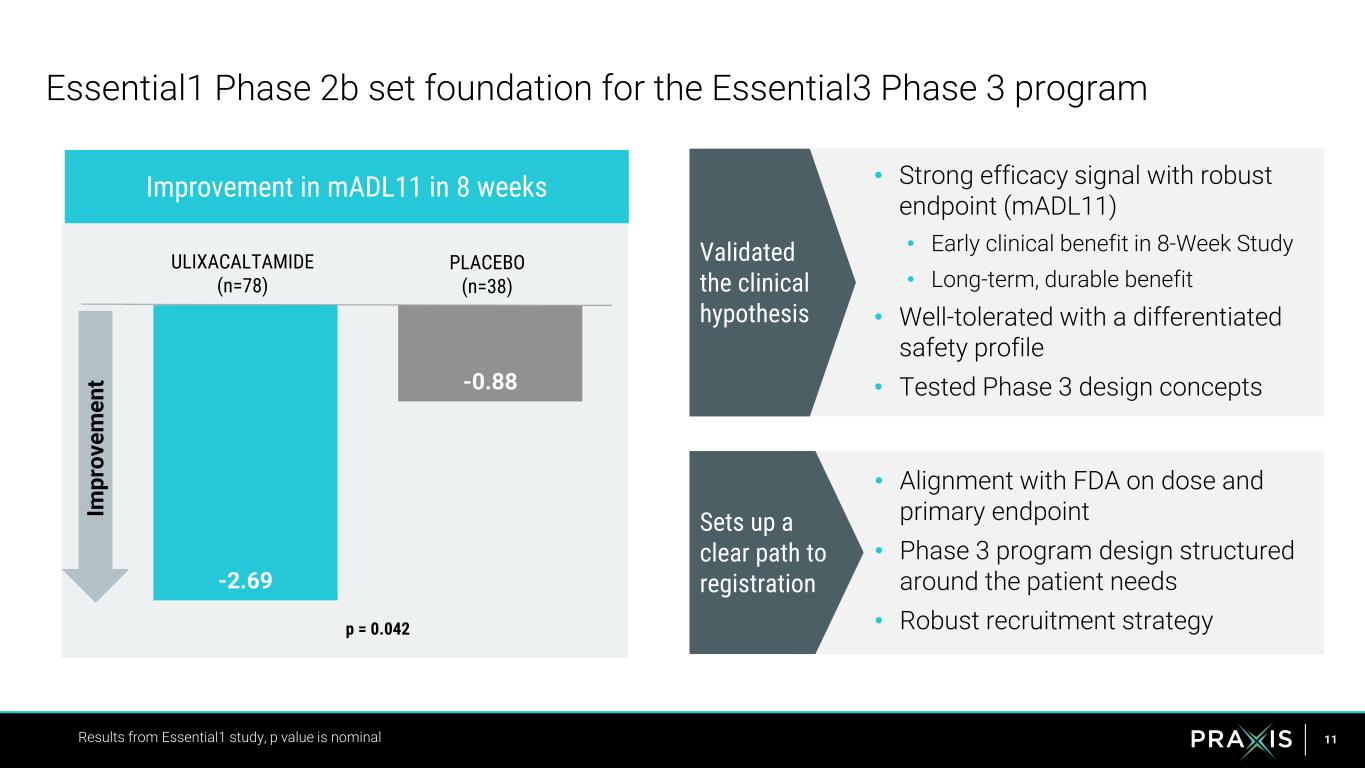
11 • Alignment with FDA on dose and primary endpoint • Phase 3 program design structured around the patient needs • Robust recruitment strategy Essential1 Phase 2b set foundation for the Essential3 Phase 3 program Sets up a clear path to registration • Strong efficacy signal with robust endpoint (mADL11) • Early clinical benefit in 8-Week Study • Long-term, durable benefit • Well-tolerated with a differentiated safety profile • Tested Phase 3 design concepts Validated the clinical hypothesis p = 0.042 ULIXACALTAMIDE (n=78) PLACEBO (n=38) Improvement in mADL11 in 8 weeks -2.69 -0.88 Im pr ov em en t Results from Essential1 study, p value is nominal

12 31% 55% 64% 0% 10% 20% 30% 40% 50% 60% 70% Placebo ulixacaltamide ulixacaltamide maintained Majority of patients achieved at least a 3-point change in mADL11 at 8 weeks Durable response in extension study patients who continued through 14 weeks Results from Essential1 study measuring participants achieving meaningful change at 8 and 14 weeks based on ≥3-point improvement from baseline https://praxismedicines.com/wp-content/uploads/2023/09/Giroux_MDS2023_E1_MSD_SUBMIT.pdf Essential1 Study – 8 weeks Essential1: % participants achieving > 3-point change in mADL11 Essential1 Extension–14 weeks p =.023
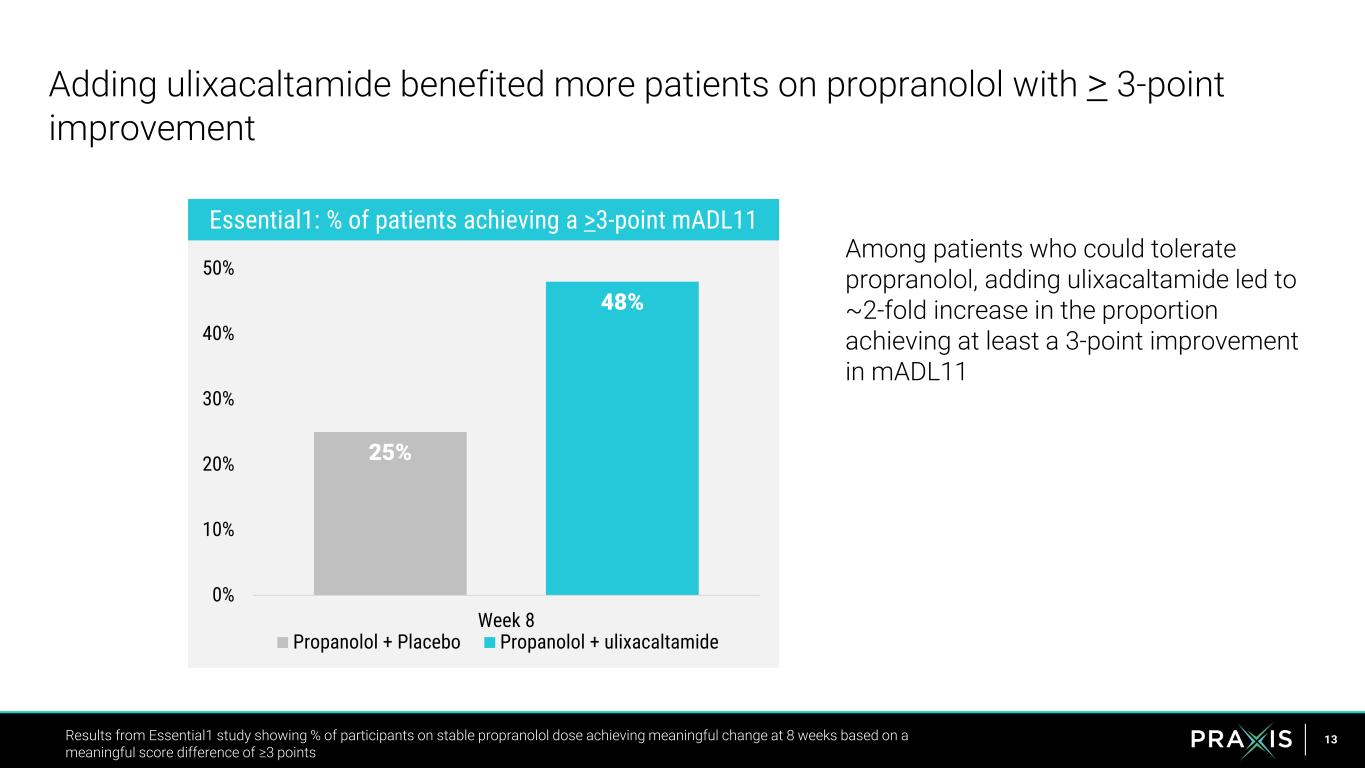
13 25% 48% 0% 10% 20% 30% 40% 50% Week 8 Propanolol + Placebo Propanolol + ulixacaltamide Adding ulixacaltamide benefited more patients on propranolol with > 3-point improvement Results from Essential1 study showing % of participants on stable propranolol dose achieving meaningful change at 8 weeks based on a meaningful score difference of ≥3 points Essential1: % of patients achieving a >3-point mADL11 Among patients who could tolerate propranolol, adding ulixacaltamide led to ~2-fold increase in the proportion achieving at least a 3-point improvement in mADL11

14 Essential3: An innovative Phase 3 program that optimizes all aspects of study conduct Single Recruiting Expert Review for Eligibility Screening Blinded Study Randomization Study 1: Placebo-controlled Parallel Group Study ulixacaltamide Placebo Study 2: Randomized Withdrawal Study ulixacaltamide Randomization 60 mg Placebo Long-term Safety Study ulixacaltamide CT.gov NCT06087276 8 weeks 4 weeks 12 weeks

15 Essential3 Program is well powered Study Study 1 – Parallel Design Study 2 – Randomized Withdrawal Participants 400 200 Primary endpoint and power mADL11 Change from Baseline to Week 12 between ulixacaltamide and placebo 90% power to detect difference Difference in maintenance of response rate during the 4- week RW period between ulixacaltamide and placebo 90% power to detect difference Stratification Intention tremor status, family history, and propranolol use Main Secondary endpoints o TETRAS-ADL o CGI o PGI CGI-S = Clinical Global Impression of Severity; PGI-S/C = Patient Global Impression of Severity/Change

16 Path to success De-risked Trial design based on key learnings from Essential1 Regulatory alignment based on successful End-of-Phase 2 meeting Efficient Focused execution Single protocol: Optimized screening, enrollment, analysis Streamlined Design Decentralized study to expand reach and reduce study burden to participants Patient-driven Approach mADL11 as a clinically meaningful primary endpoint NDA Readiness Clear path to filing in 2025
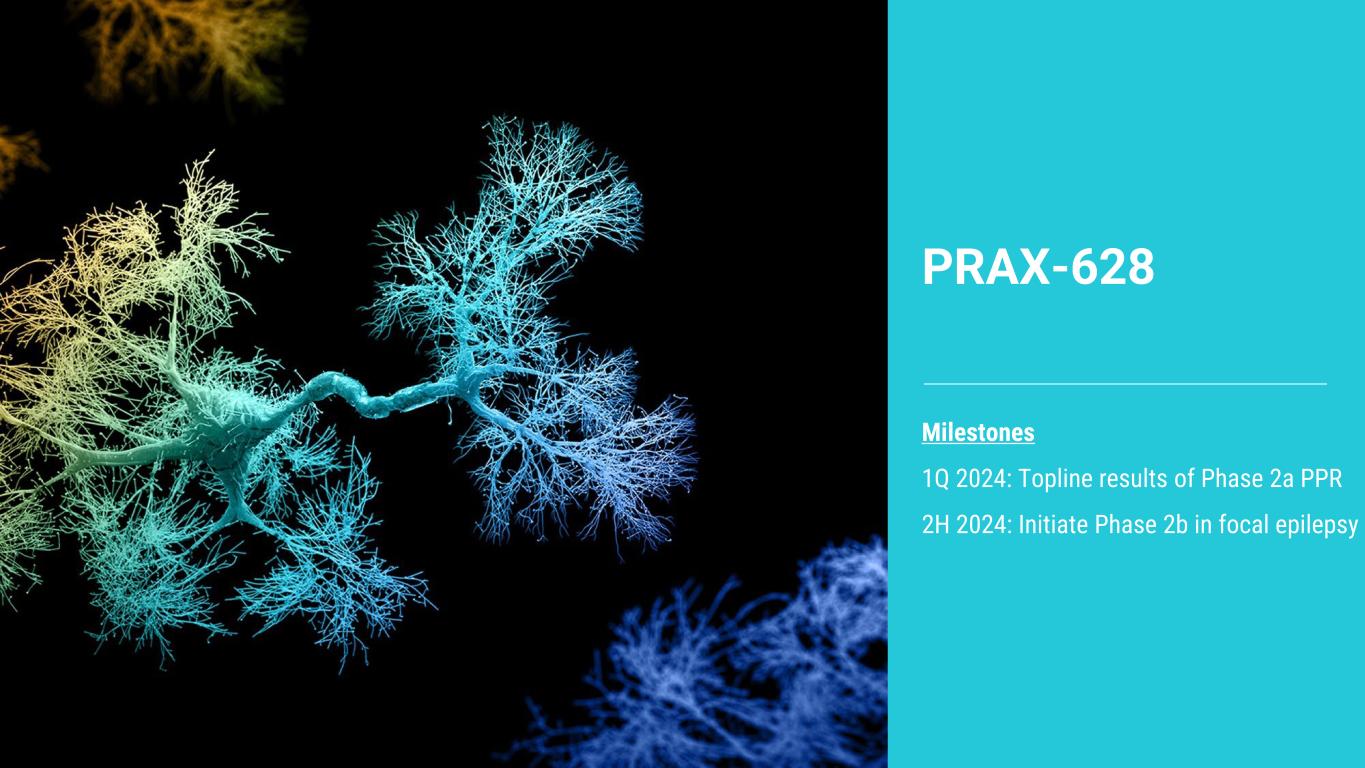
17 PRAX-628 Milestones 1Q 2024: Topline results of Phase 2a PPR 2H 2024: Initiate Phase 2b in focal epilepsy

18 The Praxis epilepsy portfolio targets significant unmet need in both the common and rare epilepsy markets >$3B+ US Common and Developmental Epilepsy Market Opportunity 3.5M US Prevalence for Common Epilepsy 14K+ US Prevalence for Rare Epilepsies covered by Praxis’ Portfolio1 1 SCN2A Gof, SCN2A LoF, SYNGAP1, PCDH19, SCN8A, KCNT1 developmental epilepsies 2 PRAX-020 (KCNT1) is a research collaboration with UCB 3 PRAX-080 (PCDH19 ), PRAX-090 (SYNGAP1) & PRAX-100 (SCN2A-LoF) ASOs are a collaboration with The Florey Institute of Neuroscience and Mental Health Praxis Epilepsy Portfolio PRAX-628 PRAX-0202 PRAX-0803 PRAX-0903 PRAX-1003 PRAX-222 PRAX-562
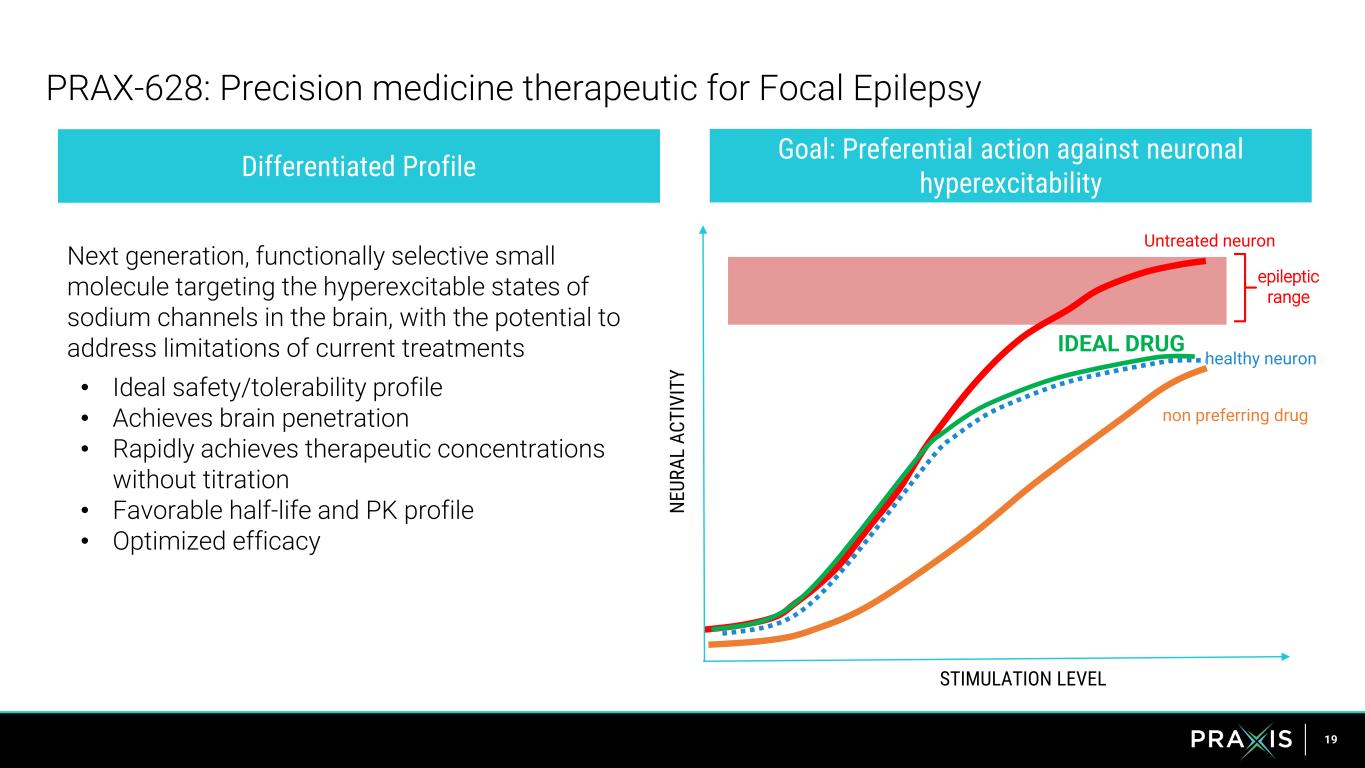
19 Differentiated Profile Goal: Preferential action against neuronal hyperexcitability PRAX-628: Precision medicine therapeutic for Focal Epilepsy Next generation, functionally selective small molecule targeting the hyperexcitable states of sodium channels in the brain, with the potential to address limitations of current treatments • Ideal safety/tolerability profile • Achieves brain penetration • Rapidly achieves therapeutic concentrations without titration • Favorable half-life and PK profile • Optimized efficacy STIMULATION LEVEL epileptic range IDEAL DRUG healthy neuron non preferring drug NE UR AL A CT IV IT Y Untreated neuron
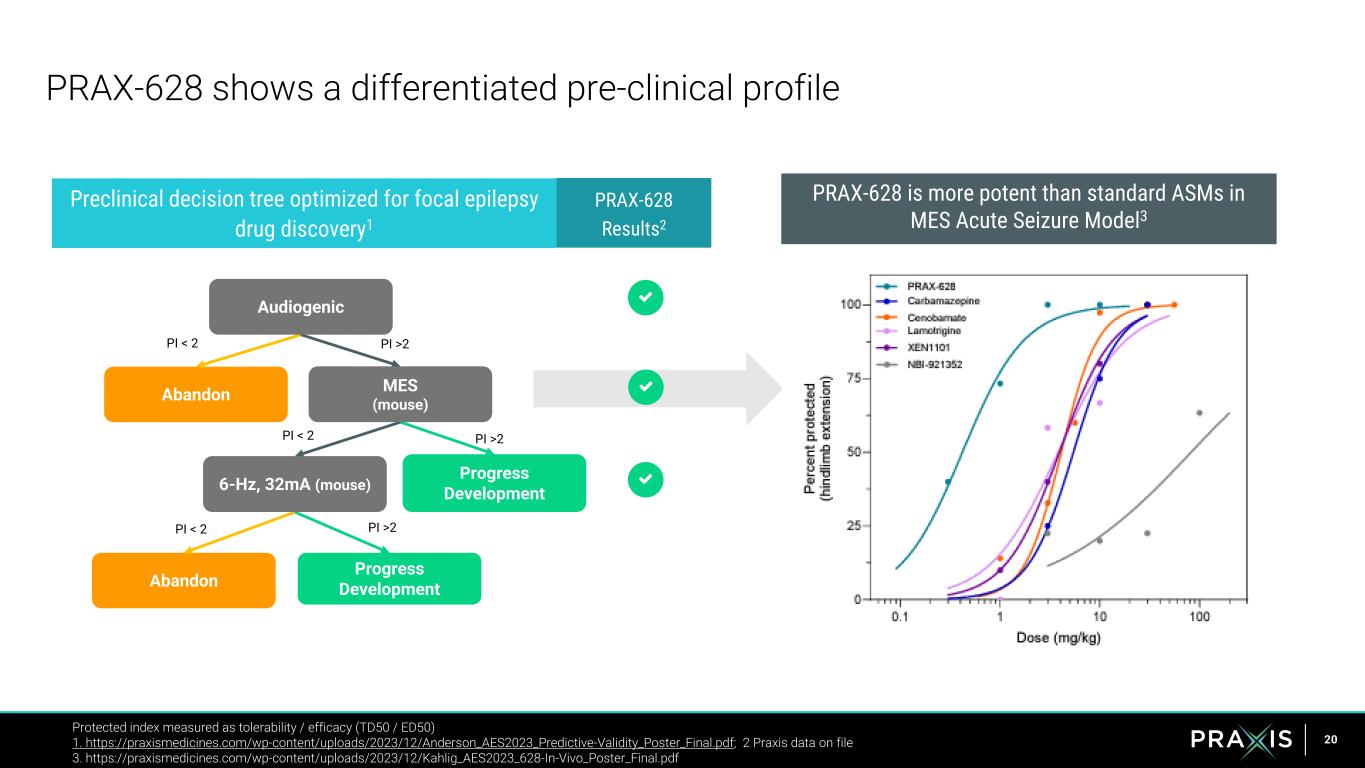
20 PRAX-628 shows a differentiated pre-clinical profile Protected index measured as tolerability / efficacy (TD50 / ED50) 1. https://praxismedicines.com/wp-content/uploads/2023/12/Anderson_AES2023_Predictive-Validity_Poster_Final.pdf; 2 Praxis data on file 3. https://praxismedicines.com/wp-content/uploads/2023/12/Kahlig_AES2023_628-In-Vivo_Poster_Final.pdf PRAX-628 is more potent than standard ASMs in MES Acute Seizure Model3 Preclinical decision tree optimized for focal epilepsy drug discovery1 Progress Development Abandon Progress DevelopmentAbandon PI >2 PI >2 PI >2 PI < 2 PI < 2 PI < 2 Audiogenic MES (mouse) 6-Hz, 32mA (mouse) PRAX-628 Results2
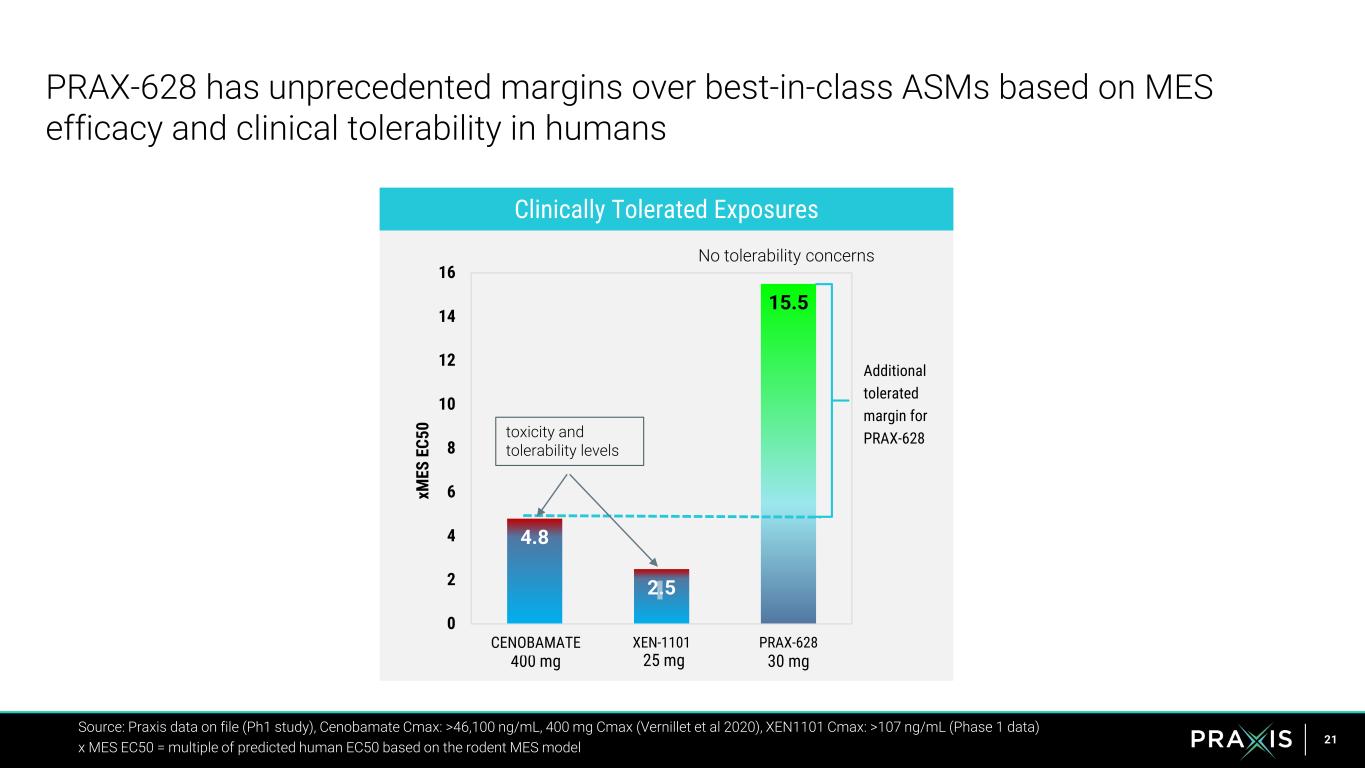
21 PRAX-628 has unprecedented margins over best-in-class ASMs based on MES efficacy and clinical tolerability in humans Source: Praxis data on file (Ph1 study), Cenobamate Cmax: >46,100 ng/mL, 400 mg Cmax (Vernillet et al 2020), XEN1101 Cmax: >107 ng/mL (Phase 1 data) x MES EC50 = multiple of predicted human EC50 based on the rodent MES model 4.8 2.5 15.5 0 2 4 6 8 10 12 14 16 CENOBOMATE XEN-1101 PRAX-628 xM ES EC 50 Additional tolerated margin for PRAX-628 No tolerability concerns toxicity and tolerability levels 400 mg 25 mg 30 mg Clinically Tolerated Exposures A
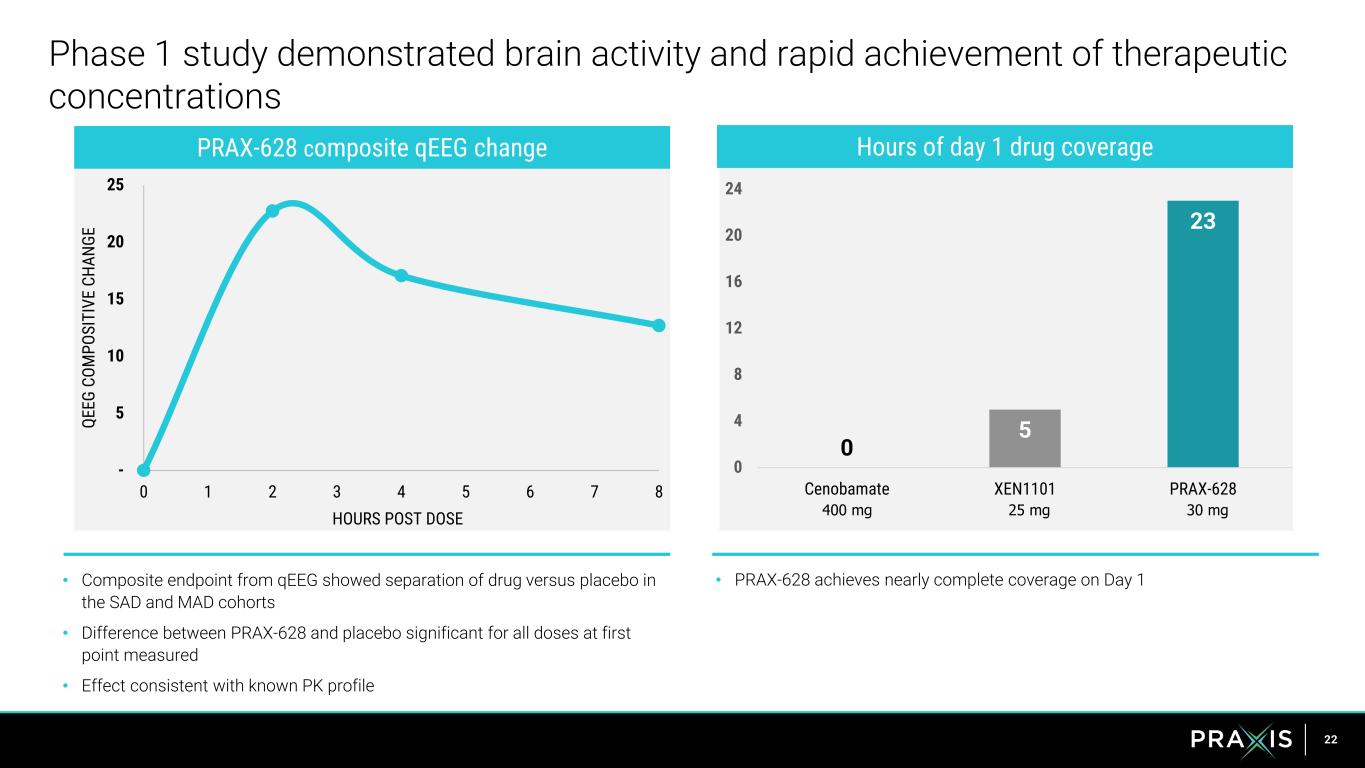
22 0 5 23 0 4 8 12 16 20 24 Cenobamate XEN1101 PRAX-628 Phase 1 study demonstrated brain activity and rapid achievement of therapeutic concentrations - 5 10 15 20 25 0 1 2 3 4 5 6 7 8 QE EG C OM PO SI TI VE C HA NG E HOURS POST DOSE • Composite endpoint from qEEG showed separation of drug versus placebo in the SAD and MAD cohorts • Difference between PRAX-628 and placebo significant for all doses at first point measured • Effect consistent with known PK profile • PRAX-628 achieves nearly complete coverage on Day 1 400 mg 25 mg 30 mg PRAX-628 composite qEEG change Hours of day 1 drug coverage
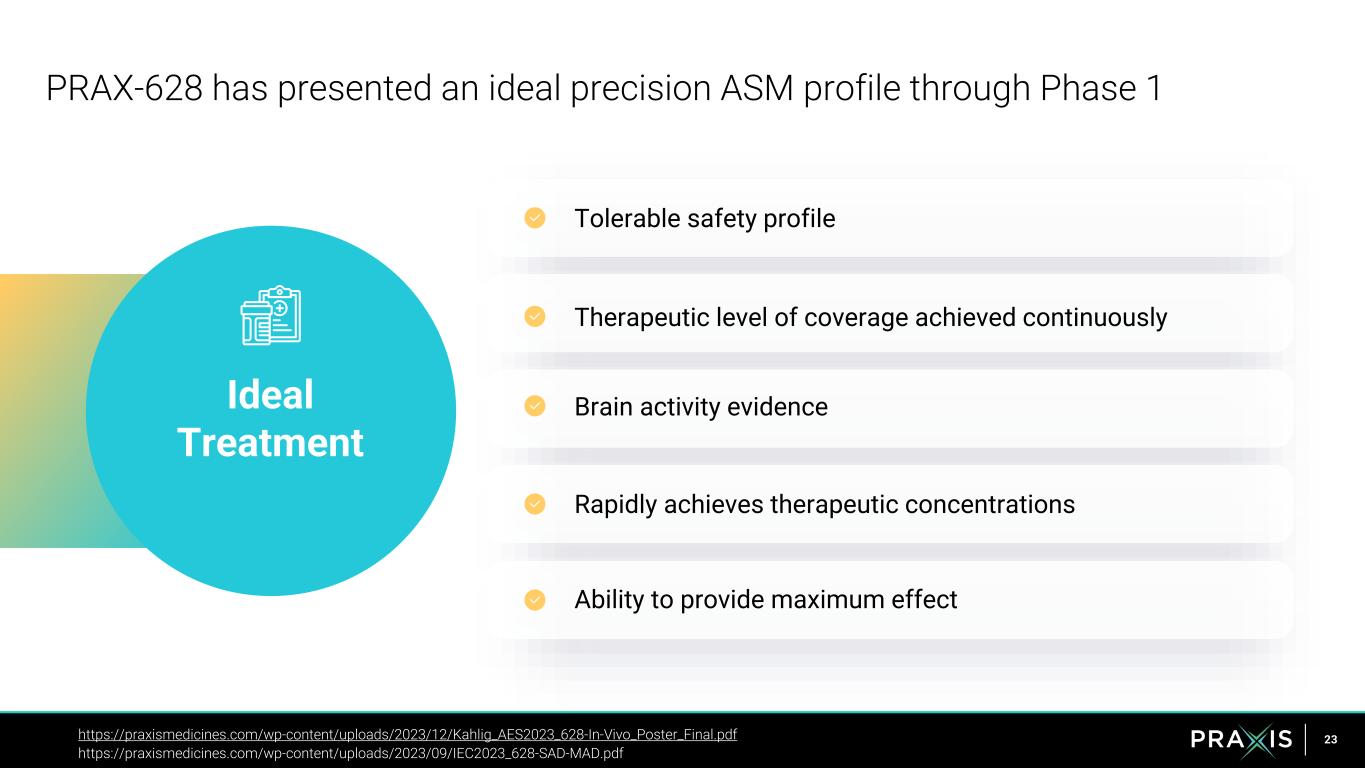
23 PRAX-628 has presented an ideal precision ASM profile through Phase 1 https://praxismedicines.com/wp-content/uploads/2023/12/Kahlig_AES2023_628-In-Vivo_Poster_Final.pdf https://praxismedicines.com/wp-content/uploads/2023/09/IEC2023_628-SAD-MAD.pdf Ability to provide maximum effect Rapidly achieves therapeutic concentrations Brain activity evidence Therapeutic level of coverage achieved continuously Tolerable safety profile Ideal Treatment
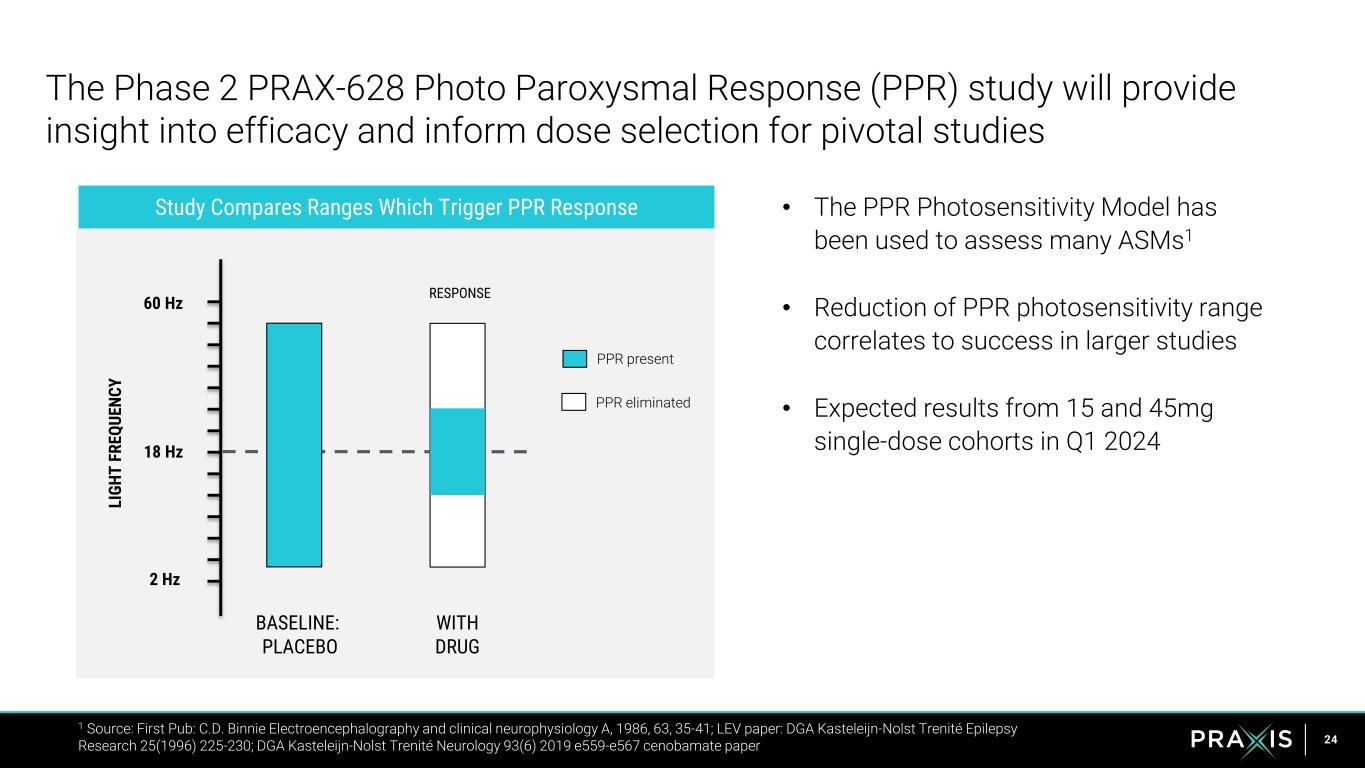
24 The Phase 2 PRAX-628 Photo Paroxysmal Response (PPR) study will provide insight into efficacy and inform dose selection for pivotal studies 1 Source: First Pub: C.D. Binnie Electroencephalography and clinical neurophysiology A, 1986, 63, 35-41; LEV paper: DGA Kasteleijn-Nolst Trenité Epilepsy Research 25(1996) 225-230; DGA Kasteleijn-Nolst Trenité Neurology 93(6) 2019 e559-e567 cenobamate paper 18 Hz 60 Hz 2 Hz BASELINE: PLACEBO WITH DRUG LI GH T FR EQ UE NC Y PPR present PPR eliminated RESPONSE • The PPR Photosensitivity Model has been used to assess many ASMs1 • Reduction of PPR photosensitivity range correlates to success in larger studies • Expected results from 15 and 45mg single-dose cohorts in Q1 2024 Study Compares Ranges Which Trigger PPR Response
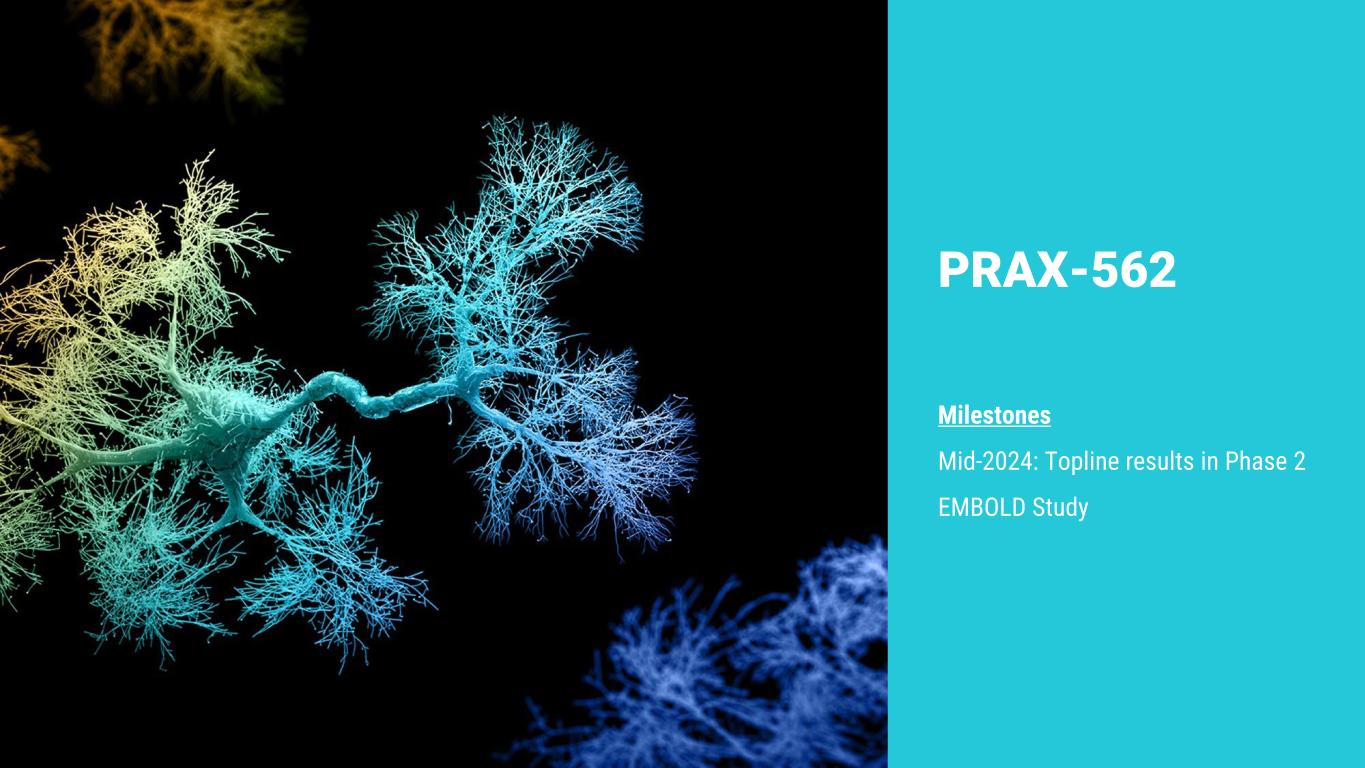
25 PRAX-562 Milestones Mid-2024: Topline results in Phase 2 EMBOLD Study
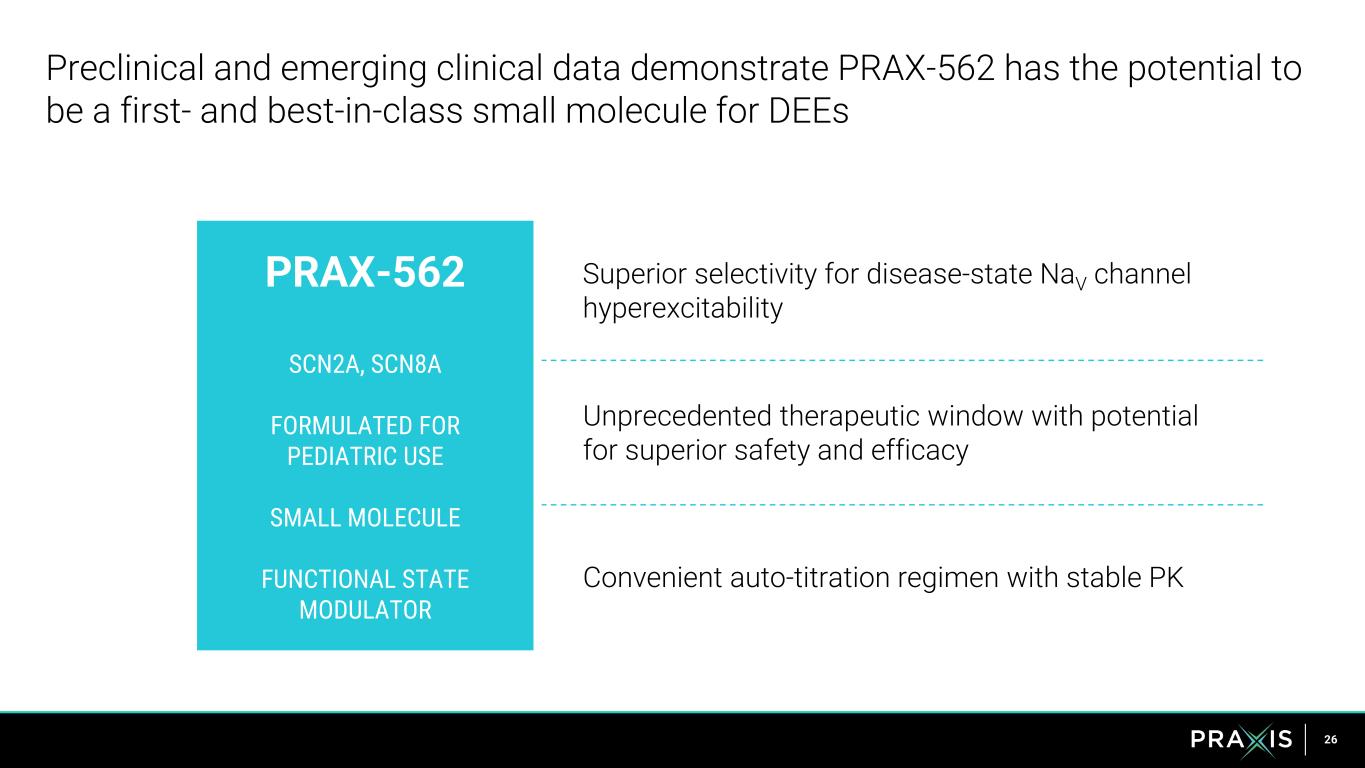
26 Preclinical and emerging clinical data demonstrate PRAX-562 has the potential to be a first- and best-in-class small molecule for DEEs Superior selectivity for disease-state NaV channel hyperexcitability Convenient auto-titration regimen with stable PK Unprecedented therapeutic window with potential for superior safety and efficacy PRAX-562 SCN2A, SCN8A FORMULATED FOR PEDIATRIC USE SMALL MOLECULE FUNCTIONAL STATE MODULATOR
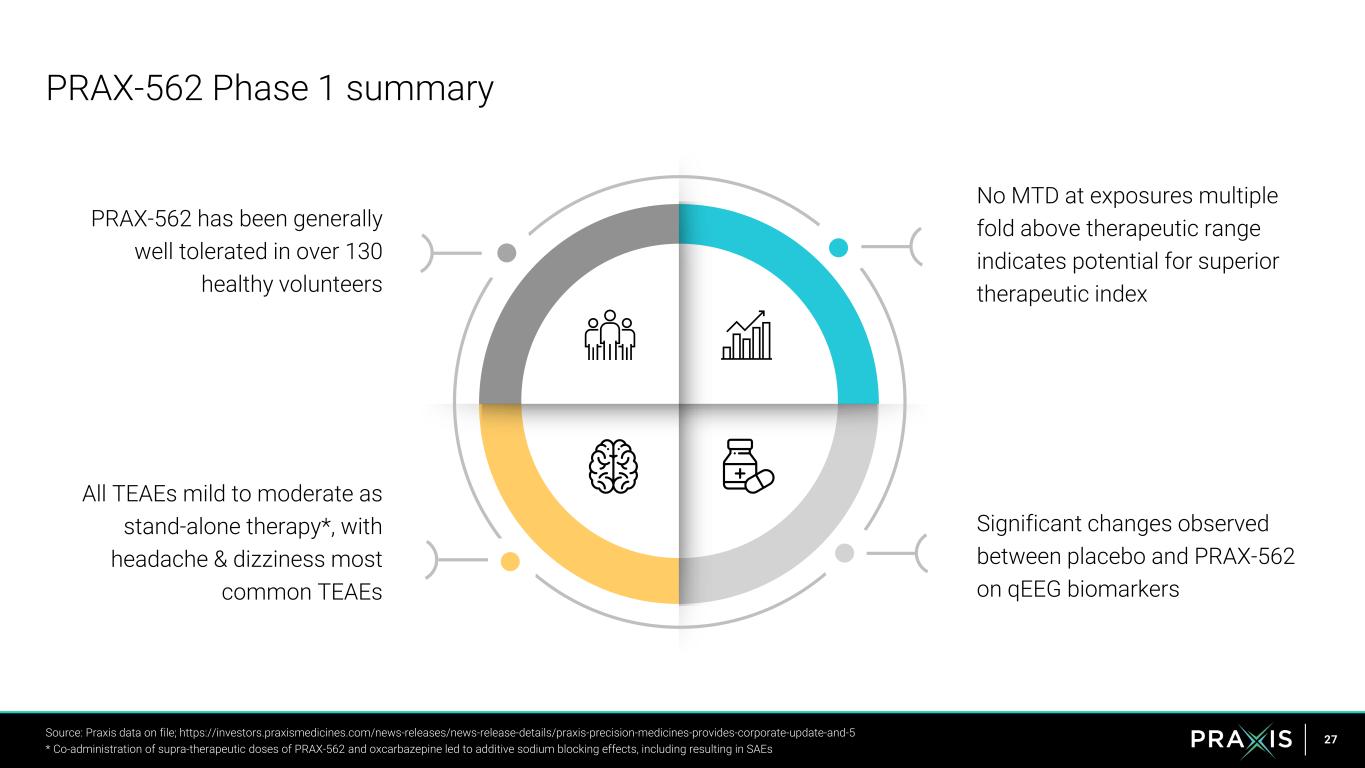
27 PRAX-562 Phase 1 summary Source: Praxis data on file; https://investors.praxismedicines.com/news-releases/news-release-details/praxis-precision-medicines-provides-corporate-update-and-5 * Co-administration of supra-therapeutic doses of PRAX-562 and oxcarbazepine led to additive sodium blocking effects, including resulting in SAEs All TEAEs mild to moderate as stand-alone therapy*, with headache & dizziness most common TEAEs Significant changes observed between placebo and PRAX-562 on qEEG biomarkers PRAX-562 has been generally well tolerated in over 130 healthy volunteers No MTD at exposures multiple fold above therapeutic range indicates potential for superior therapeutic index
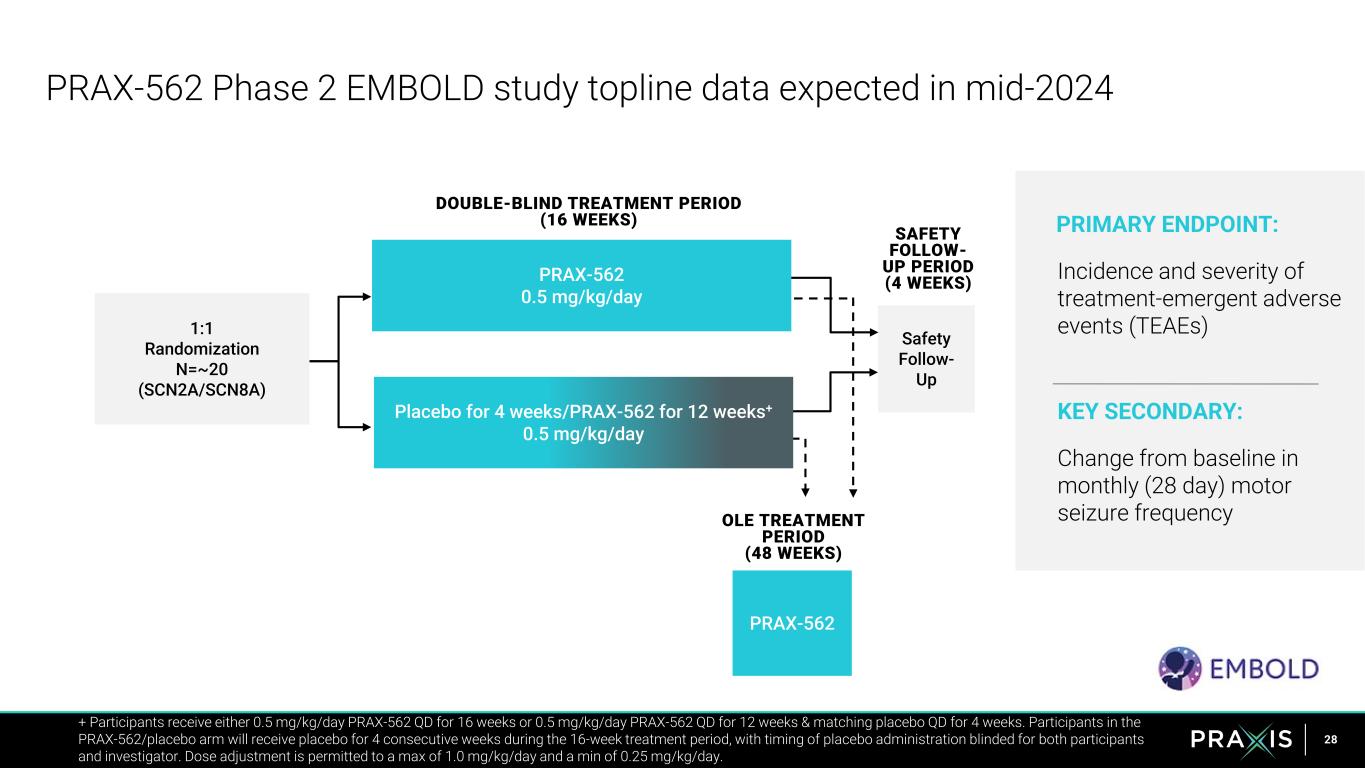
28 PRAX-562 Phase 2 EMBOLD study topline data expected in mid-2024 + Participants receive either 0.5 mg/kg/day PRAX-562 QD for 16 weeks or 0.5 mg/kg/day PRAX-562 QD for 12 weeks & matching placebo QD for 4 weeks. Participants in the PRAX-562/placebo arm will receive placebo for 4 consecutive weeks during the 16-week treatment period, with timing of placebo administration blinded for both participants and investigator. Dose adjustment is permitted to a max of 1.0 mg/kg/day and a min of 0.25 mg/kg/day. Safety Follow- Up SAFETY FOLLOW- UP PERIOD (4 WEEKS) DOUBLE-BLIND TREATMENT PERIOD (16 WEEKS) PRAX-562 1:1 Randomization N=~20 (SCN2A/SCN8A) OLE TREATMENT PERIOD (48 WEEKS) PRAX-562 0.5 mg/kg/day Placebo for 4 weeks/PRAX-562 for 12 weeks+ 0.5 mg/kg/day PRIMARY ENDPOINT: Incidence and severity of treatment-emergent adverse events (TEAEs) KEY SECONDARY: Change from baseline in monthly (28 day) motor seizure frequency
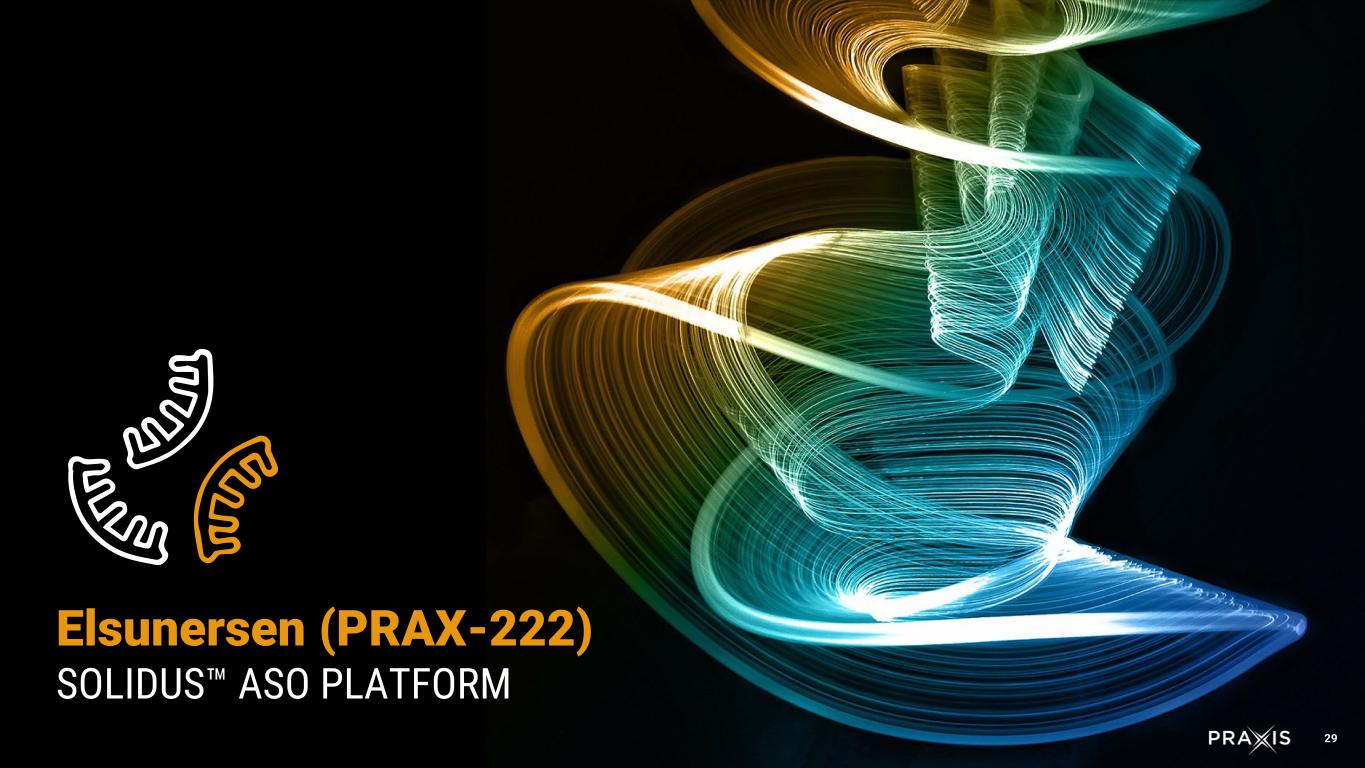
29 Elsunersen (PRAX-222) SOLIDUS ASO PLATFORM
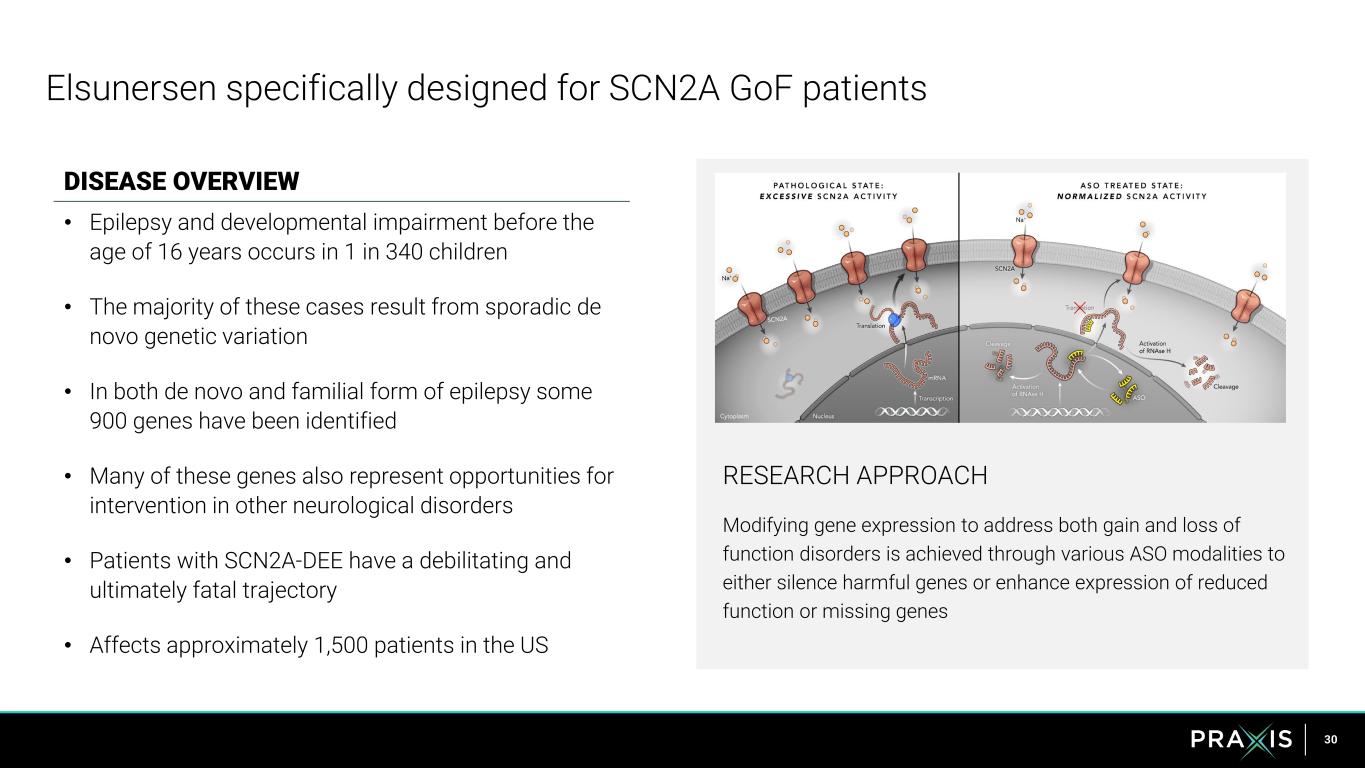
30 Elsunersen specifically designed for SCN2A GoF patients DISEASE OVERVIEW • Epilepsy and developmental impairment before the age of 16 years occurs in 1 in 340 children • The majority of these cases result from sporadic de novo genetic variation • In both de novo and familial form of epilepsy some 900 genes have been identified • Many of these genes also represent opportunities for intervention in other neurological disorders • Patients with SCN2A-DEE have a debilitating and ultimately fatal trajectory • Affects approximately 1,500 patients in the US RESEARCH APPROACH Modifying gene expression to address both gain and loss of function disorders is achieved through various ASO modalities to either silence harmful genes or enhance expression of reduced function or missing genes

31 Significant reduction in seizures observed for SCN2A patients Data from Part 1 of EMBRAVE Study, https://praxismedicines.com/wp-content/uploads/2023/12/Frizzo_AES2023_EMBRAVE_Poster_Final.pdf -39% -43% Im pr ov em en t Mean Median 52% 48% Mean Median Im pr ov em en t • No TEAEs or SAEs considered related to study drug • All TEAEs recovered/resolved Overall % reduction in seizures from 28-day baseline (n=4) Overall relative % increase in seizure-free days from 28-day baseline (n=4)
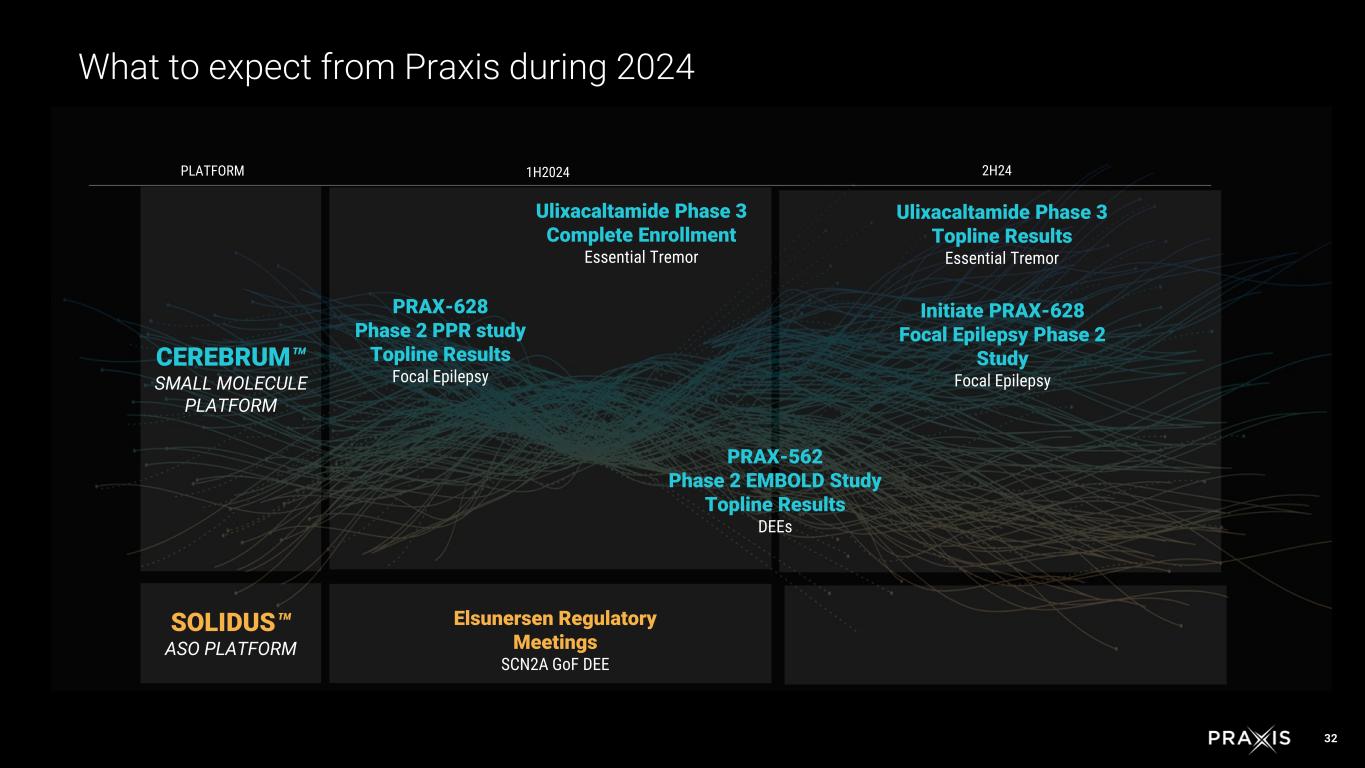
32 What to expect from Praxis during 2024 1H2024 2H24PLATFORM CEREBRUM SMALL MOLECULE PLATFORM SOLIDUS ASO PLATFORM PRAX-562 Phase 2 EMBOLD Study Topline Results DEEs PRAX-628 Phase 2 PPR study Topline Results Focal Epilepsy Ulixacaltamide Phase 3 Complete Enrollment Essential Tremor Elsunersen Regulatory Meetings SCN2A GoF DEE Ulixacaltamide Phase 3 Topline Results Essential Tremor Initiate PRAX-628 Focal Epilepsy Phase 2 Study Focal Epilepsy
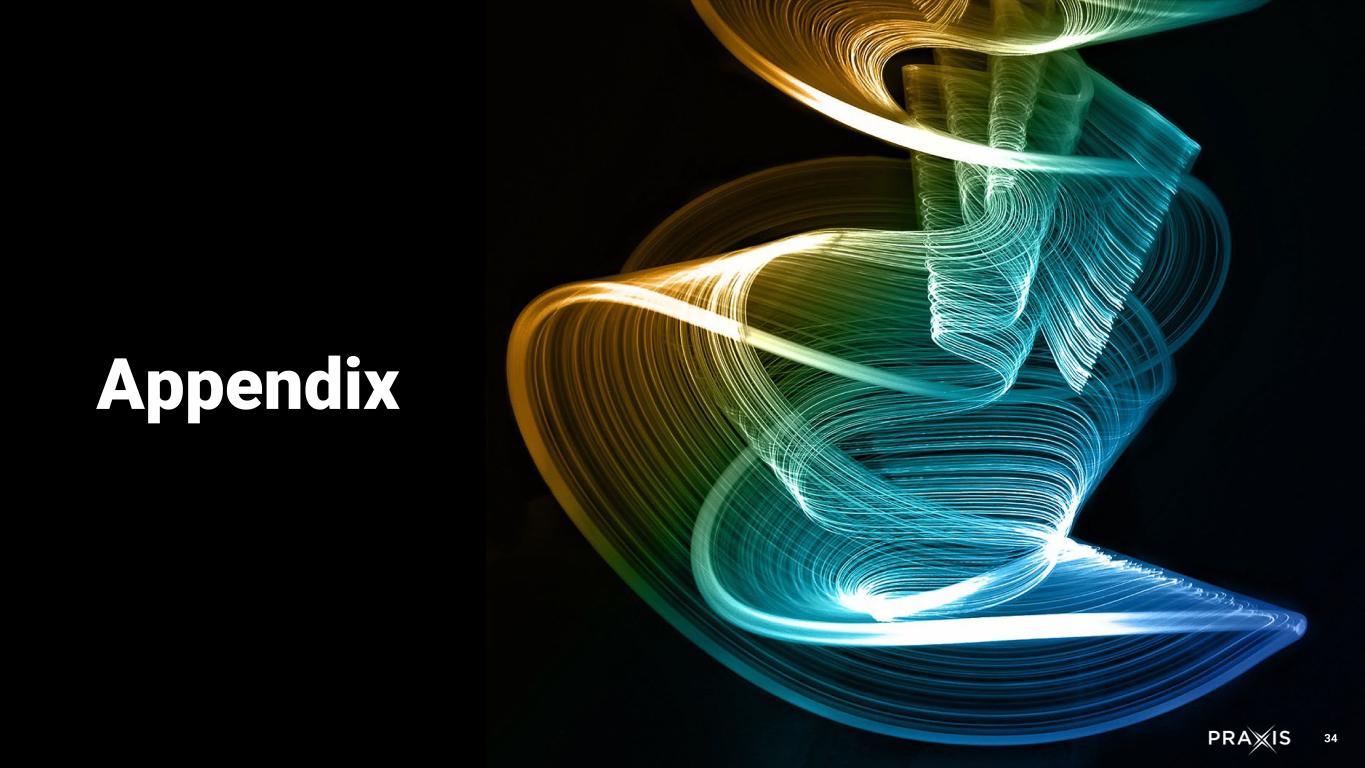
34 Appendix
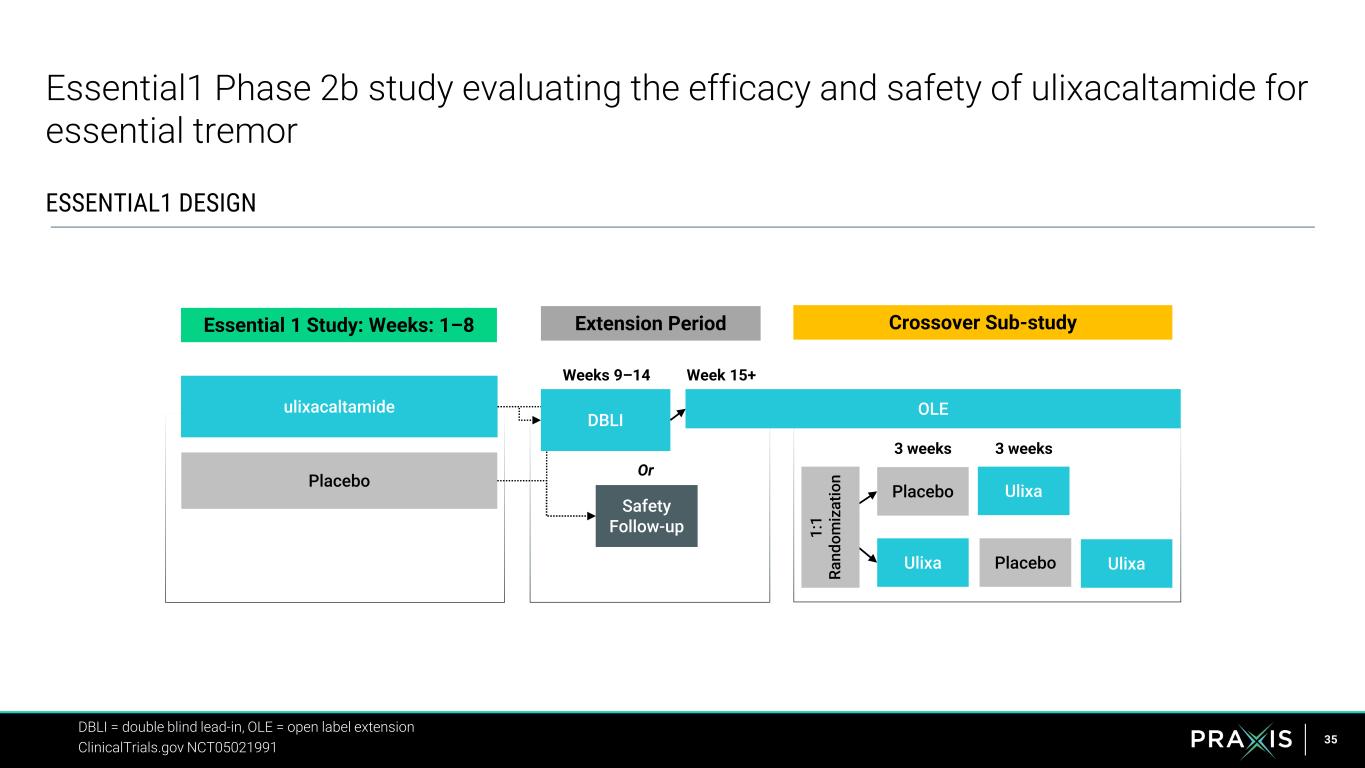
35 Essential1 Phase 2b study evaluating the efficacy and safety of ulixacaltamide for essential tremor DBLI = double blind lead-in, OLE = open label extension ClinicalTrials.gov NCT05021991 Safety Follow-up Essential 1 Study: Weeks: 1–8 ulixacaltamide Placebo Or DBLI Weeks 9–14 OLE Week 15+ Ulixa Placebo 1: 1 Ra nd om iz at io n 3 weeks 3 weeks Placebo Crossover Sub-study ESSENTIAL1 DESIGN Ulixa Ulixa Extension Period
































